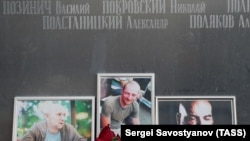Russian Foreign Ministry spokesperson Marina Zakharova said on August 2 that the reporters' bodies had gunshot wounds, but no apparent indication they had been tortured. Zakharova said the information came from the Russian embassy in the Central African Republic (CAR).
According to local and Russian officials, the three Russian reporters were killed in an ambush earlier in the week outside the town of Sibut in the CAR.
Zakharova did not provide any further details or any reference to an official CAR government statement.
The CAR Communications Ministry’s only statement, published on July 31 on Facebook, had no information about the condition of the bodies.
VOA’s French to Africa Service quoted Marcelin Yoyo, a member of Parliament from Sibut, where the journalists were killed. He said the Central African Gendarmerie went to the scene and the bodies were taken to a Sibut base of the UN mission, which also did not provide information about the bodies.
Because Zakharova’s statement signaled a denial of the rough treatment of the slain journalists, Polygraph.info decided her claim required scrutiny. But with no official forensic report yet available to the public, Polygraph.info finds Zakharova’s comment to be “unclear” at this time.
However, a local French-language news source in the CAR published a photograph of the bodies of two of the Russian journalists – identifiable as Alexander Rastorguyev and Orkhan Dzhemal - laying in an open truck.
In the photo, both bodies show multiple gunshot wounds, along with other wounds that do not seem to have been caused by bullets. Their T-shirts are bloodied and pulled up to their necks. Orkhan Dzemal’s T-shirt is visibly shredded in the back as if he was dragged over a rough surface. Both of journalists’ arms are lifted above their heads, and in Dzemal’s right hand there is a bundle of green grass squeezed in his fist.
Polygraph.info has also obtained a high resolution image of the bodies of the slain journalists and sent the photo to several forensic experts for consultation. They asked to remain anonymous, saying their analysis cannot be considered fully accurate since it is only based on the photo. Still, their consensus view was that Zakharova’s claim should be taken with a large grain of salt.
Robert Schaefer: "I have seen torture"
Retired U.S. Army Special Forces Lieutenant Colonel Robert Schaefer, a 30-year veteran and author of the bestselling book “The Insurgency in Chechnya and the North Caucasus: From Gazavat to Jihad,” told Polygraph.info that although he is not an expert, he has “seen torture,” and that a close look at the bodies “makes the Russian story” about the nature of the injuries “highly suspect.”
According to Schaefer, the man in the front of the photo (identified as Alexander Rastorguyev) “has blue lips and obvious blunt trauma - sometimes indication of a collapsed lung or too much fluid in the chest cavity due to blunt trauma such as been thrown off something and possible hitting a tree or being hit with a pipe.”
Schaefer says it doesn't look like they were dragged by vehicles because there isn't any road rash from sliding on concrete or asphalt and no tire marks indicating having been run over by vehicles.
“The man on the back of the picture (identified as Orkhan Dzemal) has a lot of blood on his shirt that looks like it came from side of head or neck. He had to be propped up in order for the blood to run down his shirt otherwise he would have bled out on the ground,” said Schaefer.
“The sideways blood spatter/wipes on both their bodies isn't consistent with any normal gunshot wounds. And given the fact that the first man has blood running down the front of his chest and a laceration on his stomach and blood going from the center out makes it unlikely that all his injuries happened at the same time.”
Schaefer considers that the goal of whoever killed the journalists was not to question them for information, “If they were interrogated, there would be wrist marks from being tied down or lacerations/bleeding on the face from being hit. However, the amount of grass that he is holding indicates that he was on the ground when he died and rigor mortis set in.”
Until there is verifiable information from the CAR government or the UN, the Polygraph.info verdict will remain as “Unclear.” That could be changed later.
In our earlier fact checks we examined circumstances of the deaths of journalists who have died while investigating the activities of the Private Military Company Wagner, as well as Wagner’s connection to the Kremlin, and what Russia is not telling about the killing of the three journalists in CAR.





